
Mar 29, 2023 | RESEARCH
Read the original article on The Basis HERE.
Editor’s Note: Today’s review is part of our month-long Special Series on Pathways to Addiction. Throughout March, The BASIS is highlighting risk factors for and pathways to addiction.
The development of the pathways model of problem and pathological gambling in 2002 was an important step towards recognizing the heterogeneity of individuals who face gambling-related harms. The model identified distinct subgroups of people experiencing problem or pathological gambling based on a variety of social, biological, and environmental risk factors. The authors, Alex Blaszczynski and Lia Nower, identified three distinct subtypes of individuals experiencing gambling problems: (1) those who were behaviorally conditioned, (2) those with pre-existing emotional vulnerabilities (e.g., anxiety, depression), and (3) those who reported frequent impulsive and/or antisocial behavior. This week, as a part of our Special Series on Pathways to Addiction, The WAGER reviews a study by Lia Nower and colleagues that updated and revised the original pathways model.
What were the research questions?
Does the pathways model of problem and pathological gambling require revision? What revisions or additions should be made to the pathways model?
What did the researchers do?
The researchers surveyed 1,168 individuals with moderate to severe gambling problems seeking treatment across the United States, Canada, and Australia. Participants completed the Problem Gambling Severity Index (PGSI) and the Gambling Pathways Questionnaire (GPQ). The PGSI is a well-regarded and frequently used research instrument to measure the presence and severity of an individual’s gambling problems. On the other hand, the GPQ is an instrument designed to categorize individuals experiencing problem gambling based on the risk factors that they might have experienced. Using participants’ scores on the 11 subscales of the GPQ, the researchers performed latent class analysis to identify subgroups of individuals experiencing problem gambling.
What did they find?
Similar to the original pathways study, the latent class analysis identified three distinct subgroups. Class 1, the largest class, had the lowest average (i.e., mean) scores on each of the GPQ subscales. Class 2 was characterized by high levels of anxiety and depression, both pre- and post-problem gambling, in addition to a high rate of childhood maltreatment (see Figure 1). Finally, Class 3 comprised individuals who scored high in impulsivity and reported frequent risk-taking and/or antisocial behavior (see Figure 2). In terms of problem gambling severity, Class 2 had the highest average scores, while Class 3 scored only slightly lower. Notably, the research team also found some overlap between classes. For example, Classes 2 and 3 both reported gambling to cope with stress, though only Class 3 reported gambling to find meaning.
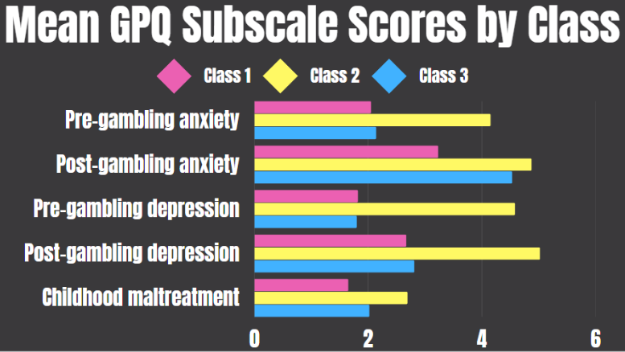
Figure 1. Gambling Pathways Questionnaire (GPQ) subscales that differentiate Class 2 from Classes 1 and 3. The total possible range for each GPQ subscale varies and is calculated by summing the responses within each subscale.

Figure 2. Gambling Pathways Questionnaire (GPQ) subscales that differentiate Class 3 from Classes 1 and 2. The total possible range for each GPQ subscale varies and is calculated by summing the responses within each subscale.
Why do these findings matter?
Recognizing the heterogeneity of pathways to problem gambling within this population is important because it allows treatment professionals to focus on the most salient risk factors for gambling problems rather than more tangential issues. For example, impulsivity is considered an important risk factor for Gambling Disorder and some interventions focus on modulating impulsivity. However, because only a subset of participants experienced heightened impulsivity, it is possible that significantly more people who experience gambling problems would instead benefit from safer product design that disrupts the conditioning aspects of gambling, such as mandatory breaks or the use of self-limit features (e.g., limiting time or amount wagered per gambling session).
Every study has limitations. What are the limitations in this study?
This study only included individuals who were seeking treatment for Gambling Disorder, so the findings might not apply to non-treatment seeking individuals experiencing gambling problems. Additionally, the GPQ measures pre-gambling anxiety/depression by asking participants to retrospectively recall their feelings though research suggests these measures are unreliable.

Jan 4, 2023 | CONCERNED OTHERS, RESEARCH
Read the original article on the Basis website HERE.
By John Slabczynski
With online gambling revenue projected to surpass $150 billion by 2030, developing a better understanding of the causes and consequences of gambling-related problems is especially important. A key focus in those suffering from gambling problems is the family, as family members are greatly impacted by problem gambling. However, some evidence also indicates that one’s family can potentially contribute to the risk of developing gambling problems. This week, The WAGER reviews a study by Marie Aime Uwiduhaye and colleagues that examined the role of family in the relationships among psychosocial risks, gambling problems, and other adverse outcomes.
What were the research questions?
What are the psychosocial correlates of gambling problems? Does family dysfunction moderate the relationship among gambling problems and negative outcomes, including drug misuse, alcohol dependence, anti-social behavior, and poor sleep quality?
What did the researchers do?
The researchers recruited 104 men from casinos in Musanze, Rwanda during 2019. Participants completed a number of self-report survey items, including questions about their gambling, substance use, sleep quality, family relationships, and mental health. The researchers used a combination of Pearson’s r correlation analyses and regression analyses to examine relationships. First, they examined the correlations between gambling problems and all other variables. Next, they examined these relationships through a series of regression analyses that also assessed the role of family dysfunction as a moderator.
What did they find?
Nearly half (44%) of participants reported high-risk gambling, with 37% reporting moderate risk gambling and 19% reporting low-risk gambling (see Figure). As expected, people with more severe gambling problems reported worse drug and alcohol problems (perhaps due to self-medication), as well as more insomnia, anti-social behavior, and family dysfunction. However, among participants with relatively high levels of family dysfunction, the links between problem gambling severity, and drug misuse, alcohol dependence, and insomnia (but not anti-social behavior) were stronger, suggesting that family dysfunction elevates the risk for these gambling harms.

Figure. Proportion of participants in the low-risk, moderate-risk, and high-risk gambling categories, and correlates of high-risk gambling.
Why do these findings matter?
These findings help explain the relationship between gambling problems and frequently comorbid conditions including substance misuse. Clinicians need to understand each individual client’s pattern of co-occurring conditions, including which are primary and which are secondary, to address the root causes of distress. In addition, improving our understanding of both the causes and consequences of gambling-related problems can help enhance evidence-based treatments, which can be administered earlier in the development of problems. For example, the results of this study suggest that evidence-based treatments focused on the family, such as community reinforcement and family training, may decrease substance misuse in addition to gambling by improving family functioning.
Every study has limitations. What are the limitations in this study?
This study’s recruiting strategy was rather limited. The authors employed a convenience sample that only included men gambling at a casino. As a result, their findings might not be representative of other gamblers and the rate of high-risk gambling should not be interpreted as a prevalence estimate. Additionally, due to the cross-sectional nature of the data, we cannot be certain whether one variable causes another. Future studies should include a wider range of participants and collect data over time to better assess causality.
For more information:
Individuals who are concerned about or want to change their gambling habits can find support services through the National Council on Problem Gambling or Gamblers Anonymous.

Dec 9, 2022 | RESEARCH
Read the original article on the basis website HERE.
By Kira Landauer, MPH
Gambling can lead to adverse consequences, including financial, social, emotional, occupational, and physical harms. Not only do these harms impact the gambler, but they can ripple across their social network and negatively affect the gambler’s intimate partners, family, and friends (referred to as concerned significant others, or CSOs). This week, The WAGER reviews a study by Nerilee Hing and colleagues that examined the prevalence of CSOs harmed by gambling in Australia, and the types of harms experienced by these CSOs based on their relationship to the person who gambles.
What were the research questions?
What is the national prevalence of CSOs harmed by gambling in Australia? What are the types and frequencies of harms experienced by CSOs based on their relationship to the person who gambles?
What did the researchers do?
The researchers conducted a national mobile telephone survey with 11,560 respondents in Australia during October and November of 2019. The sample was weighted to align with the current population of Australia. Participants were asked whether they had been personally affected by another person’s gambling in the past 12 months; those who responded yes were defined as a CSO. These respondents were then asked about their relationship with the person whose gambling most affected them, and also selected which of 25 harms they experienced because of that person’s gambling. Harms were classified into five categories: (1) emotional, (2) financial, (3) health, (4) relationship, and (5) work/study.
What did they find?
Six percent of respondents reported that they had been negatively affected by another person’s gambling in the past 12 months. CSOs were most often affected by a non-family member’s gambling (39.4%), followed by any family member’s gambling (38.9%). Women were more likely than men to experience harm due to their child’s or a current or former spouse/partner’s gambling, whereas men were more likely than women to experience harm due to the gambling of a non-family member (e.g., a friend or coworker).
Emotional harms were the most frequently reported category of harm overall (89.3%) and across all types of CSO-gambler relationships (see Figure). Relationship harms were the second most frequently reported category of harm (76.2%). The least reported category of harm by CSOs was work/study (29.1%). Overall, CSOs experienced a mean of 7.2 harms (median = 6). CSOs impacted by a former spouse/partner’s gambling reported the greatest number of harms, followed by current spouse/partner, parents, and children, respectively. CSOs affected by a work colleague or others’ gambling reported the least number of harms. Spouses/partners and family members were more likely than non-family members to report emotional, relationship, and health harms. CSOs harmed by a current or former spouse/partner’s gambling or their child’s gambling were most likely to experience harm in the majority of harm categories. Finally, women reported experiencing a higher number of harms (mean = 7.7) than men (mean = 6.54).

Figure. Harms experienced by concerned significant others (CSOs) who have been negatively affected by someone’s gambling in the past 12 months, by the type of relationship with the gambler and type of harm. Relationship types were categorized as partner (current spouse/partner; former spouse/partner), family member (parent; sibling; child; other relative) and non-family member (friend, work colleague/other). Total sample size is n = 686.
Why do these findings matter?
These findings add to our understanding of the negative impacts that gambling can have on the individuals within a gambler’s social network. Findings from this study demonstrate the need to recognize and support CSOs in coping with a loved one’s gambling; a specific focus should be placed on supporting spouses, partners, and close family members of the gambler, who are likely to experience the greatest number of harms. Providers should be aware of how to support their clients who are negatively affected by a loved one’s gambling. Additionally, support services tailored to women CSOs are needed given that women CSOs are more likely to experience a greater number of harms due to a loved one’s gambling than men.
Every study has limitations. What are the limitations of this study?
Respondents only reported on harms experienced from the person whose gambling harmed them the most. It is possible that respondents were impacted by more than one person’s gambling but that information was not captured in this study. This study did not include or report on gambling harms experienced by children. As such, the findings are likely only generalizable to the adult population.
For more information:
Do you think you or someone you know has a gambling problem? Visit the National Council on Problem Gambling for screening tools and resources. Gam-Anon is a community of self-help support groups for concerned significant others impacted by a loved one’s gambling.

Nov 8, 2022 | RESEARCH
Read the original article on the basis website HERE.
By Taylor Lee
Gambling is easily accessible to many people in the United Kingdom (UK), including adolescents, so it is important to be aware of the development of potential problems. Particularly with the widespread use of smartphones or computers, people can gamble from almost anywhere. Despite a legal gambling age of 18 in the UK, many younger individuals have both exposure (e.g., via advertisements or parental gambling) and access (e.g., with fake IDs and unregulated gambling). Some studies have found that underage participation in gambling is associated with adult Gambling Disorder. This week, The WAGER reviews a study by Amanda Roberts and colleagues that examined UK teachers’ lack of confidence in handling students’ gambling problems as compared to students’ drug or alcohol problems.
What was the research question?
What are teachers’ awareness of and attitudes towards adolescent gambling in the UK?
What did the researchers do?
This study surveyed 157 primary and secondary school teachers from UK mainstream schools using Qualtrics. In addition to demographic questions, teachers were assessed on their awareness of gambling involvement and problems among 11 – 16-year-olds. Teachers rated the seriousness of adolescent concerns and behaviors, reported how frequently they discuss these issues with students, and rated their confidence in handling various problems with Likert scale measures. The researchers calculated descriptive statistics for teachers’ awareness and used Cochran-Q tests of association and logistic regression analyses to compare teachers’ attitudes about gambling and confidence in addressing gambling in comparison to other adolescent concerns and behaviors.
What did they find?
Teachers viewed adolescent gambling as less serious compared to other adolescent concerns and behaviors such as negative body image, smoking, or academic problems. They discussed gambling with students the least frequently of all adolescent issues (see Figure) and reported significantly less confidence in addressing gambling problems when compared to other adolescent concerns and behaviors. Teachers also viewed excessive video gaming as more serious than gambling, suggesting that teachers may be unaware of similarities between the two.
 Figure. Percentages of teachers who discussed each high-risk behavior frequently (picking “sometimes”, “often”, or “regularly”). Total n = 157 primary and secondary school teachers from mainstream schools in the UK. Adapted from Figure 3 in Roberts et al. (2022).
Figure. Percentages of teachers who discussed each high-risk behavior frequently (picking “sometimes”, “often”, or “regularly”). Total n = 157 primary and secondary school teachers from mainstream schools in the UK. Adapted from Figure 3 in Roberts et al. (2022).
Why do these findings matter?
It is important to provide teachers with clear information about the dangers of underage gambling and tools to address problems if they arise. This study suggests that UK teachers likely need more awareness about gambling-related harms to help prevent students from engaging in underage gambling or harmful gambling behaviors. If teachers are adequately trained, they may be more comfortable starting conversations about the dangers of gambling and providing resources to at-risk students. Additionally, they will know how to appropriately approach a student with a gambling problem and provide support while pointing them to healthcare providers or treatment sources.
Every study has limitations. What are the limitations of this study?
This study has a small sample size, so results might not be generalizable to all teachers in the UK or in other countries. Also, this study did not provide participants with a clear definition of gambling behavior, which might have led to ambiguity over what behaviors should be counted as gambling. The wording of phrases such as “excessive video game playing” compared to “gambling” may have contributed to gambling appearing as a less severe issue.
For more information:
Do you think you or someone you know has a gambling problem? Visit the National Council on Problem Gambling for screening tools and resources. Individuals in the UK can visit GamCare for problem gambling information and helpful resources. For additional resources, including gambling and self-help tools, please visit The BASIS Addiction Resources page.

Oct 7, 2022 | RESEARCH
Read the original article on The Basis website HERE.
By Kira Landauer, MPH
Recovery capital refers to the internal and external resources that an individual can access to start and sustain recovery from an addictive disorder. Existing along a continuum, recovery capital can be negative and impede an individual from enacting change and overcoming their addiction, or positive and help to enhance the recovery experience. This week, The WAGER reviews a study by Belle Gavriel-Fried and Niva Lev-el that identified and modeled elements of negative recovery capital (NRC) that might impede recovery from Gambling Disorder.
What was the research question?
What are the NRC elements that impede recovery from Gambling Disorder?
What did the researchers do?
The researchers conducted semi-structured interviews with 133 individuals with a self-reported lifetime history of Gambling Disorder. Participants were currently in treatment or had recently been treated in five gambling treatment centers in Israel and reported no co-occurring substance use disorder within the past year. The authors asked the research participants to describe factors that impeded or made their recovery process from Gambling Disorder more challenging. Next, the researchers analyzed the interviews using deductive and inductive qualitative content analyses. They categorized factors that impeded recovery into the four domains of recovery capital and then assessed their frequencies: (1) Human Capital (skills, personal traits, and knowledge); (2) Social Capital (family and friends, social networks); (3) Financial Capital (financial assets, such as money); and (4) Community Capital (community resources that promote social norms of a recovery lifestyle).
What did they find?
Fourteen elements of NRC were identified and categorized across the four domains of recovery capital. The majority of participants (82%) reported at least one NRC element in the domain of Negative Human Capital as a barrier to their recovery. This domain included negative emotional, cognitive, and behavioral states and negative life circumstances, including cognitive distortions, which were cited by 36% of participants (see Figure). Of the 14 NRC elements, the most frequently cited obstacle to recovery was conflictual or dangerous social networks, cited by 56% of participants. This NRC element is within the Negative Social Capital domain, which includes lack of support from family and friends. Sixty-three percent of participants cited at least one element in this domain as an obstacle to their recovery. An environment that encourages gambling and financial distress and debts were frequently cited NRC elements, and belong to the Negative Community Capital and Negative Financial Capital domains, respectively.

Figure. Frequencies for negative recovery capital elements that impede recovery from Gambling Disorder across the four domains of negative recovery capital (n = 133). Adapted from Gavriel-Fried & Lev-el (2022).
Why do these findings matter?
These findings illustrate the many challenges and obstacles that might impede or hinder an individual’s recovery from Gambling Disorder, and this study is the first effort to map these elements across various domains pertinent to the recovery process. This study found that many elements that challenge the recovery process fall within the Human Capital domain, suggesting a focus be placed on addressing factors within this domain during recovery (e.g., addressing cognitive distortions through cognitive behavioral therapy or motivational interviewing). Findings from this study reinforce the importance of social networks in the recovery process, and highlight that unsupportive or conflictual relationships can hinder the recovery process. Clinicians should consider including family members into the treatment process and help clients manage relationships within their social networks. While it may be beneficial to prioritize these more common NRC elements, these results suggest that a holistic approach be taken to treatment and recovery. A tailored approach should address the full range of obstacles or challenges that might impede recovery across social, financial, personal, and community domains.
Every study has limitations. What are the limitations of this study?
This study used data from individuals without an active substance use disorder who sought help for their gambling. Findings might not be generalizable to individuals with an active substance use disorder, individuals who have not sought treatment for their Gambling Disorder, or to those residing in other countries.
For more information:
Do you think you or someone you know has a gambling problem? Visit the National Council on Problem Gambling for screening tools and resources.

Oct 7, 2022 | PROBLEM GAMBLING, RESEARCH
Read the original article on The BASIS.
By Caitlyn Matykiewicz, MPH
Social casino games have become very popular during the past decade. Typically played on mobile devices, these online games are connected to social networking sites, allowing players to see their scores on leaderboards and share results with their friends. Social casino games resemble gambling activities like slot machines (aka electronic gambling machines [EGMs]), even including similar sounds and offering in-game purchases or microtransactions with rewards of virtual points. Because they are free to play and the player cannot win any real money from the outcome, social casino games are not currently considered gambling. However, people who play simulated gambling games, such as social casino gamers, might be more likely to experience gambling problems. This week, The WAGER reviews a study by Hyoun S. Kim and colleagues that investigated motives for playing social casino games and transitioning between social casino games and gambling.
What were the research questions?
Why do people who gamble play social casino games? Why do people transition from social casino games to gambling? Why do people transition from gambling to social casino games?
What did the researchers do?
The researchers recruited 269 United States residents who both gambled and played social casino games. Through an online survey, participants provided their top three reasons for playing social casino games, transitioning to gambling after playing social casino games, and transitioning to social casino gaming after gambling. Participants also completed the Problem Gambling Severity Index (PGSI). The researchers conducted a thematic analysis of participant responses and identified key motives for each of the three research questions.
What did they find?
For all three research questions, the most frequently mentioned motive was playing for enhancement–in other words, to experience fun, entertainment, excitement, or thrill (see Figure). Participants also played social casino games to alleviate boredom (46%) and for social reasons (29%). Among participants who started with social casino games and transitioned to gambling, 70% reported the opportunity to win real money as a motive for doing so. Availability (42%) and affordability (31%) were common reasons for switching from gambling to social casino games. Gambling-harm minimization was another motive for playing social casino games, among all participants (17%) and among those who transitioned from gambling (28%). Motives for playing social casino games did not differ by PGSI score category.

Figure. Top two reported motives for why people (a) play social casino games, (b) transition from social casino games to gambling, and (c) transition from gambling to social casino games.
Why do these findings matter?
Social casino games can be a potential precursor to gambling and gambling problems. A majority of participants reported that they began gambling as a way to win real money, which is concerning because social casino games have inflated payout rates that could give players a false perception of skill. Players should be informed that their odds of winning in social casino games do not necessarily reflect the odds of winning in gambling.
On the other hand, many participants reported playing social casino games to reduce the chance of gambling harm, as it can satisfy their urge to gamble without them risking any real money. Social casino games may be a potential harm reduction strategy to help people with gambling problems cut down on their gambling behavior, though more research is needed to determine its effectiveness and the harm that results from spending too much time on social casino gaming.
Every study has limitations. What are the limitations in this study?
Participants were limited to United States residents who both gambled and played social casino games, so the results might not be generalizable to people who live in other countries or to people who currently play social casino games but have not yet transitioned to gambling. Because this study was cross-sectional, we also cannot determine whether any of these motives actually caused changes in social casino gaming or gambling behavior.
For more information:
Do you think you or someone you know has a gambling problem? Visit the National Council on Problem Gambling for screening tools and resources. For additional resources, including gambling and self-help tools, please visit our Addiction Resources page.
Page 7 of 11« First«...56789...»Last »


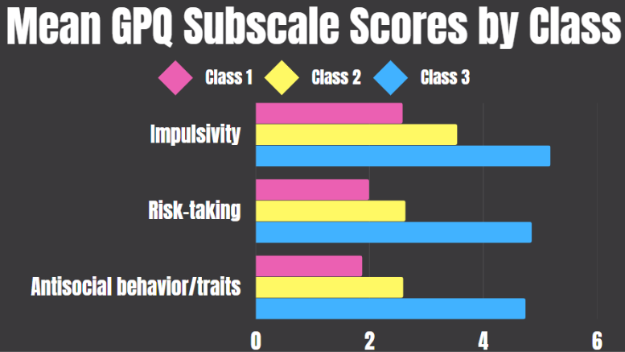
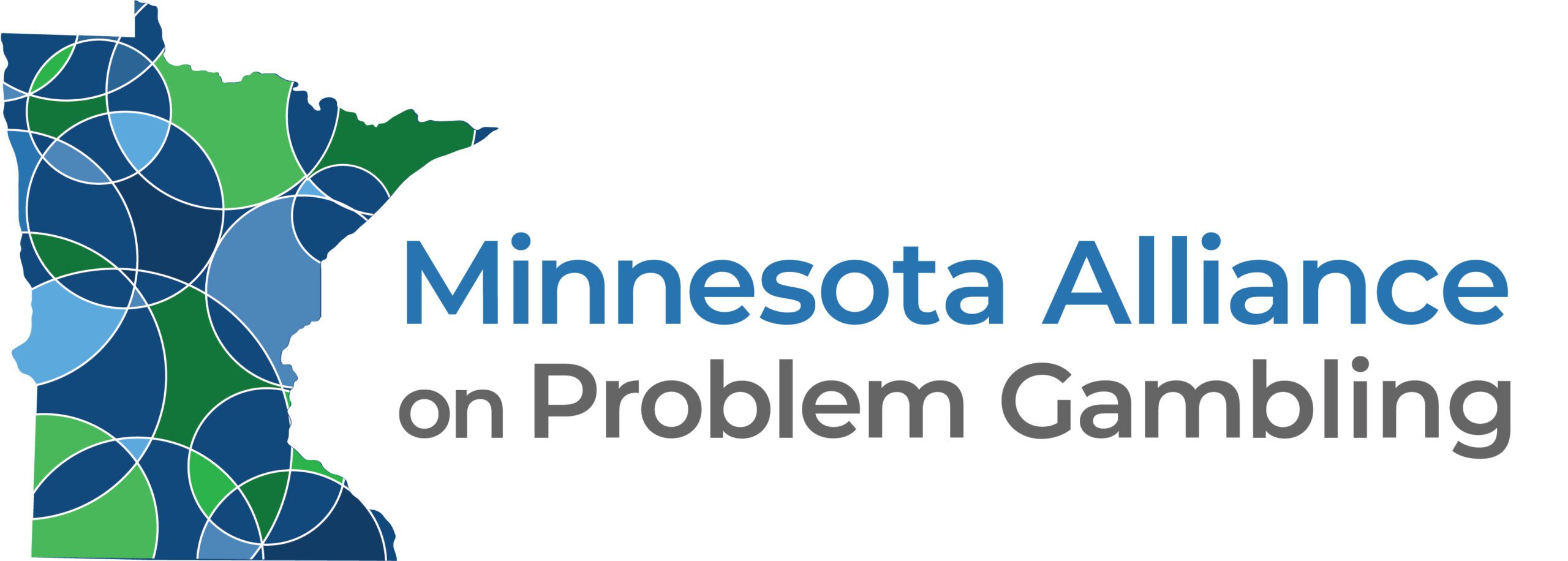

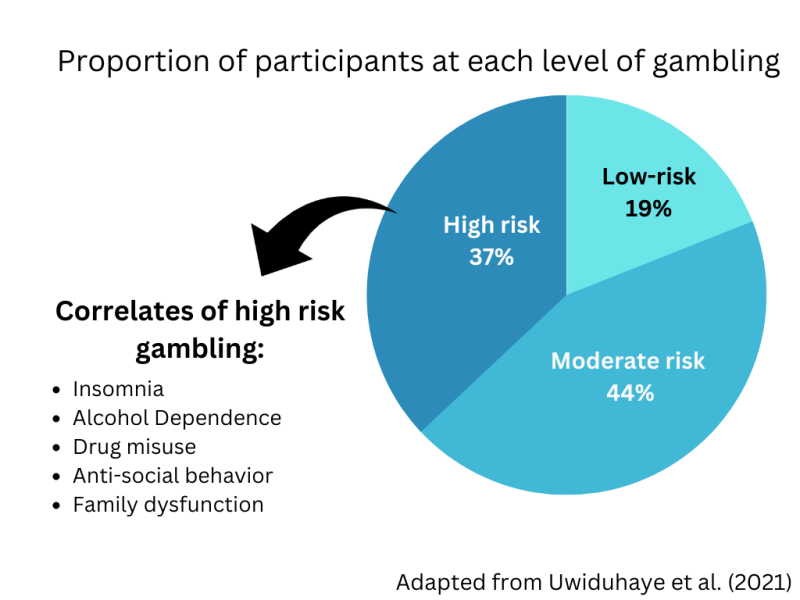



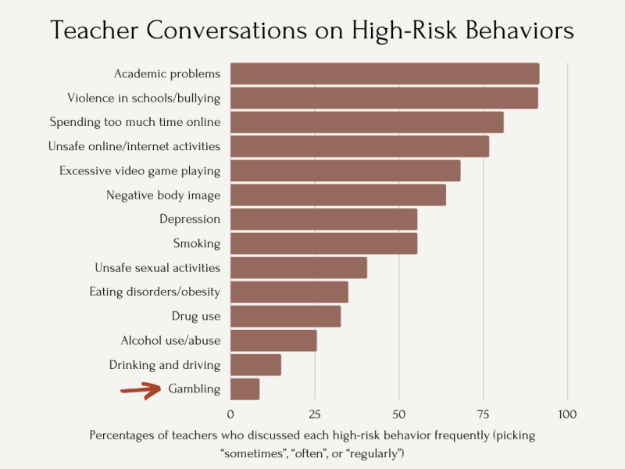 Figure. Percentages of teachers who discussed each high-risk behavior frequently (picking “sometimes”, “often”, or “regularly”). Total n = 157 primary and secondary school teachers from mainstream schools in the UK. Adapted from Figure 3 in Roberts et al. (2022).
Figure. Percentages of teachers who discussed each high-risk behavior frequently (picking “sometimes”, “often”, or “regularly”). Total n = 157 primary and secondary school teachers from mainstream schools in the UK. Adapted from Figure 3 in Roberts et al. (2022).


